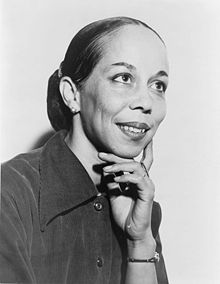Janet Collins, OblSB (March 7, 1917 – May 28, 2003) was an African American prima ballerina, choreographer, and teacher. She performed on Broadway, in films, and appeared frequently on television.[1] She was among the pioneers of black ballet dancing, one of the few classically trained Black dancers of her generation.

Biography
editJanet Faye[2] Collins was born in New Orleans, and at the age of four moved with her family to Los Angeles, California,[3] where Collins received her first dance training at a Catholic community center. She studied primarily with Carmelita Maracci, Lester Horton, and Adolph Bolm, who were among the few ballet teachers who accepted black students.[1] She also had fond memories of studying with Los Angeles dance teacher Dorothy Lyndall.[4]
In 1932, aged 16,[5] Collins auditioned with success for the prestigious Ballet Russe de Monte Carlo, but as she was required to paint her face and skin white in order to be able to perform, she did not join the company. In the 1940s, Collins collaborated with well-known dancer Katherine Dunham and joined the Dunham Company.[6] A turning point in her dance career came in November 1948, when she performed in a one-night program at the Las Palmas Theater in Los Angeles. She earned excellent notices.[7] In 1948, she moved to New York and got the chance to dance her own choreography on a shared program at the 92nd Street YMHA.[8]
In 1949, Collins earned glowing reviews in a variety of performances, including the Broadway production of Cole Porter's musical Out of This World for which she received the Donaldson Award for best dancer on Broadway in 1951. It was in that role that she was noticed by Zachary Solov, then the ballet master of the Met.[7]
She also performed in Aida, Carmen, and was the first Black ballerina to perform at the Metropolitan Opera in 1951[9] which she joined the next year and performed at until 1955.[10] In later life Collins taught modern dance at Balanchine's School of American Ballet in New York City,[3] and at Marymount Manhattan College in New York City[11] from 1951 until 1972.[12] In 1974, Collins retired from performing and teaching,[2] devoting herself to her Catholic religion and finding comfort as an oblate in the Benedictine Order. She was also an accomplished painter.[13]
In failing health, she moved to Fort Worth from Seattle in 2000 to be closer to her brother, Ernest Patrick Collins, who survives her, as does her sister, Betty Wilkerson of Pasadena, Calif.[7] Janet Collins died in 2003 at the age of 86, in Fort Worth, Texas.
Legacy
editJanet Collins' dance reputation today resides primarily in her role in breaking the colour barrier; the constraints on Black classical dancers were too strong for her to have a vibrant performing career.[14] In some Southern cities, race laws kept her off the stage, and her parts were played by understudies. After a performance in Toronto, Dance Magazine reported some years ago, she and a colleague approached the door of an obviously crowded restaurant only to be turned away with the curt statement that the establishment was closed.[15]
In 1974, the Alvin Ailey American Dance Theater paid homage to her and Pearl Primus as pioneering black women in dance. Collins received a Candace Award from the National Coalition of 100 Black Women in 1989.[16] In 2007, in recognition of Collins' great work and dedication, her renowned cousin Carmen De Lavallade established the Janet Collins Fellowship to honor aspiring talented ballet dancers.[17]
References
edit- ^ a b Dunning, Jennifer. "Janet Collins, 86: Ballerina Was First Black Artist at Met Opera", The New York Times, May 31, 2003.
- ^ a b Glenn, Aszemar (3 March 2014). "Janet Faye Collins (1917-2003) • BlackPast". BlackPast. Retrieved 30 October 2019.
- ^ a b David Vaughan, Janet Collins obituary, The Guardian, June 11, 2003.
- ^ Lewin, Yaël Tamar; Collins, Janet (2011-09-13). Night's Dancer: The Life of Janet Collins. Wesleyan University Press. pp. 62–63. ISBN 978-0-8195-7115-1.
- ^ "The Dancer Who Made History 64 Years Before Misty Copeland". Time. Retrieved 2019-05-01.
- ^ Durkin, Hannah (May 2013). "Cinematic "Pas de Deux": The Dialogue between Maya Deren's Experimental Filmmaking and Talley Beatty's Black Ballet Dancer in A Study in Choreography for Camera (1945)". Journal of American Studies. 47 (2): 385–403. doi:10.1017/S0021875813000121. ISSN 0021-8758. S2CID 144363190.
- ^ a b c Thurber, Jon (2003-06-02). "Janet Collins, 86; Broke Ballet Color Line". Los Angeles Times. ISSN 0458-3035. Retrieved 2018-04-08.
- ^ Pocantico Hills School Archived 2013-05-24 at the Wayback Machine.
- ^ "1951 – Janet Collins joins with Metropolitan Opera Ballet – MOBBallet.org". mobballet.org. Retrieved 30 October 2019.
- ^ "1955 – Janet Collins retired from the Metropolitan Opera Ballet – MOBBallet.org". mobballet.org. Archived from the original on 4 August 2020. Retrieved 30 October 2019.
- ^ "Janet Collins, American dancer" at Encyclopædia Britannica′s Guide to Black History.
- ^ "Marymount Manhattan History"
- ^ Yael Tamar Lewin, Night's Dancer, The Life of Janet Collins, Wesleyan University Press, 2011
- ^ Melville Digital Development, L. L. C. (2018-02-23). "Celebrating Black History Month: Spotlight on Janet…". Atlanta Ballet. Archived from the original on 2023-06-08. Retrieved 2020-10-09.
- ^ Thurber, Jon (2003-06-02). "Janet Collins, 86; Broke Ballet Color Line". Los Angeles Times. ISSN 0458-3035. Retrieved 2018-04-09.
- ^ "CANDACE AWARD RECIPIENTS 1982-1990, Page 2". National Coalition of 100 Black Women. Archived from the original on March 14, 2003.
- ^ "The Carmen De Lavallade Awards for Dance: Janet Collins Fellowship" Archived 2016-07-10 at the Wayback Machine, New York Institute of Dance & Education.
External links
edit- "Janet Collins, American dancer" at Encyclopædia Britannica′s Guide to Black History